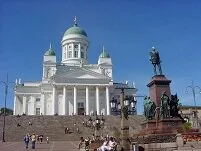Architecture of Finland

Senate Square in Helsinki
Most of Finland's architecture was made of wood so few of their historic buildings are still standing today. Due to this there are also few old stone buildings in the country, however one place that has both of these is the city of Rauma. The Holy Cross Church from the 1400s is one of the country's oldest still standing stone buildings, while much of the rest of the town is in wood, although much of it was rebuilt in the 1600s. A great example of original wooden architecture is the Petajavesi Old Church, which was built in the 1700s and is in the Gothic and Renaissance styles.
It wasn't until the 1800s when much of Finland, and in particular, modern day Helsinki was built. At the time neo-Classicism was well accepted in the capital and today much of the city remains in this style. The city's most well-known landmarks are all in this style, including the Lutheran Cathedral and the rest of Senate Square.